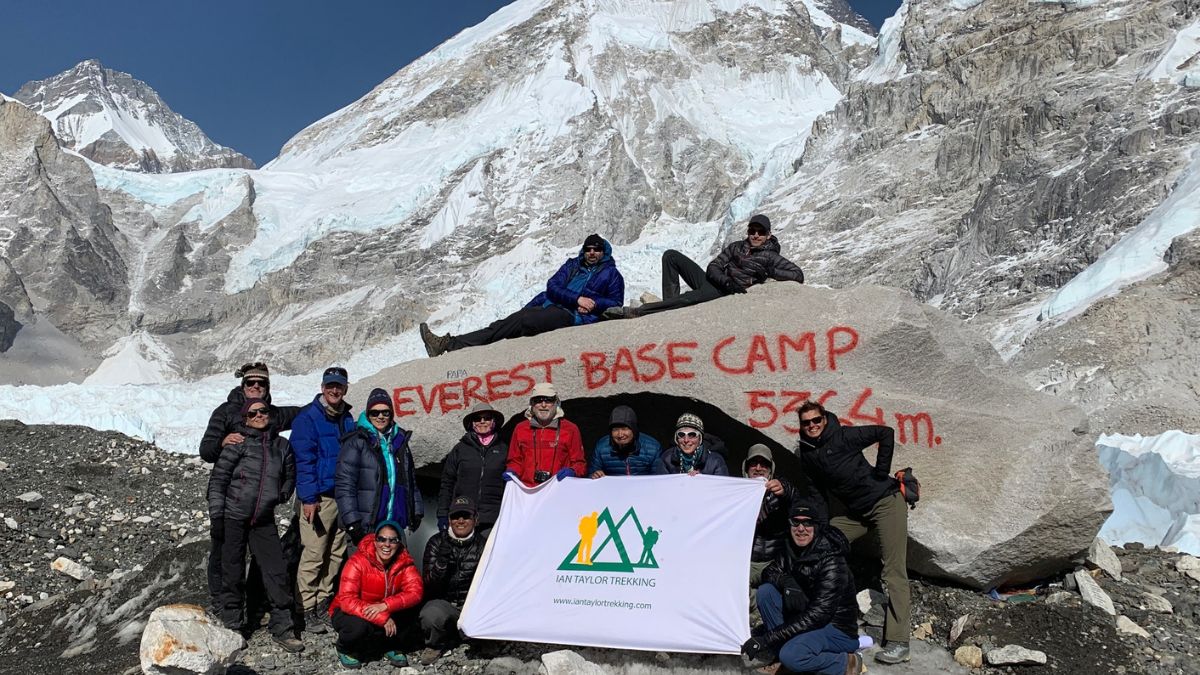Entertainment
Everest Base Camp Trek with Sherpas What You Need to Know Before You Go

Everest Base Camp Trekking stands as one of the most memorable adventures that attracts travelers all over the globe to the lowest area infront of the highest mountain in this world. But this is no easy walk in the park. Preparation, of course, is key but at the same time there is no better way to do the trek than with Sherpas. Sherpas are more than guides – they are the backbone of the Everest region, providing invaluable support that goes beyond your basic physical needs by ensuring you don’t fall off cliffs and gain perspectives that would be impossible without their local knowledge. Everything to Know Before Leaving on This Amazing Trip with Sherpas-to-Trek-to-EBC-
Everest Base Camp Trek is about 130 km round-trip, with an ascent from Lukla at 2860 meters to the highest point at the Base Camp of it standing proud at 5,364 m. This is something you need to be aware of the physical challenges of such a trek as well, particularly at altitude. The main difficulty of the trek is the danger of altitude sickness. The Sherpas have a near-encyclopedic knowledge of the area and its ecosystem, which is invaluable for helping trekkers acclimatize correctly. Their knowledge of pacing and experience with rest days while steadily increasing elevation gain to reduce the chance for altitude sickness is priceless.
The Sherpas also provide crucial assistance with navigation, especially in the changeable and volatile mountain weather that is often so treacherous. During the best trekking season, however, the weather in the Everest region can be unpredictable-north winds, snow storms and torrential rainfall, a common occurrence. Sherpas know naturally about these circumstances and can lead trekkers to the most secure courses, dodging potential dangers.
Not only do they bring expertise in the mountains, but Sherpas also add a richness of culture to those on trek with them. Often, they are the first to enlighten trekkers with the spiritual significance of this magical land — imparting stories and wisdom regarding Buddhist customs, holy sites, and the meaning behind prayer flags, Mani stones, and monasteries along the path. Their bond with the land is deeply spiritual, and they are both guides and custodians of the culture within that landscape.
With respect to logistics, trekking with Sherpas does away with most of the difficulties that are presented by the isolation of the region. Sherpas will help you pack, arrange porters and make sure that trekkers have the right gear. They know the areas best suited to be rested, where the water and food management might go down, and the best places to stay.
In conclusion, this famous trek can be done with an acute level of safety and respect for local culture whilst feeling much sooner to the Himalaya on more well trodden paths by trekking Sherpa. And if you desire either physical achievement or a spiritual experience, Sherpas don about being the best insurers of your adventure — both safe and truly meaningful.
Using Sherpas to Trek EBC: An Introduction
Everest Base Camp (EBC) trek is one of the toughest yet rewarding in the world. But with the rugged, demanding terrain of Nepal so high from sea-level that even seasoned environments may struggle to cope with its altitude and lack of oxygen, nothing comes without a price. Introduction Trekking with Sherpas The indigenous people of the Everest region are Sherpa, and thus you have top a reliable guide well aware of the entire trek and its environment, culture along with physical challenges. All of their trekking experience up there, weather knowledge, and cherished local wisdom is needed to keep things safe and culturally true. And Sherpas are key part of acclimatizing you to the high altitude, avoiding altitude sickness and leading you safely through sometimes treacherous terrain. Aside from their practical know-how, Sherpas provide insight into the Everest region’s spiritual and cultural significance, deepening your experience. Trekking with Sherpas is integral not just to guidance but connect the touristic experience to the history and mind of the Himalayas itself, granting guests something special and timelessly unique.
Guide to the Everest Base Camp Trek: An Overview
The Everest Base Camp Trek: One of the World Most Iconic Journeys from Lukla to Mount Everest Basecamp, 5,364m It is a tough trek which normally take around 12-14 days through a distance of about 130km (round trip). The trek takes many days through the Khumbu Valley, stopping at famous villages such as Namche Bazaar, Tengboche and Dingboche. Trekkers witness scenic view of Everest | Image: Creative CommonsAlong the way, trekkers traverse through densely forested land, alpine meadows and difficult terrain soaking in sweeping views of some of the highest peaks on earth including Everest, Lhotse and Nuptse. Since acclimatization is one of the biggest elements that considering altitude sickness and this trekking itinerary includes strategized rest days to adapt towards ever-increasing high-altitudes. Himalayas Trekking: The trek is of moderate difficulty level so a good fitness & mental soundness is needed to complete this trek, but the work done before departing will make it great fun for many who are guided well (say by a Sherpa). It is not only a physical journey to Base Camp but also an onward experience because during this trek, trekkers walk through various Sherpa villages, impressive Buddhist Monasteries, and other spiritual places.
The Best Season for Trekking to EBC
The right time to trek to Everest base camp is crucial for true success and enjoyment during your trekking holiday. The two best seasons to hike to EBC are pre-monsoon (spring) and post-monsoon (autumn). The spring season, spanning from late March to early June, is also quite popular thanks to clear conditions (the ice melts away), warmer temperatures and green scenery at last. The months during this season provide clear sight of mountains and the best for treks if you want to behod yourself in colourful rhododendron forests. Another perfect season for the EBC trek is autumn, from late September to early November. This period also enjoys relatively stable weather, clear skies and milder temperatures; the ideal time for trekking. Fall is also when many festivals are celebrated in the region including the famous Mani Rimdu creating opportunities to look at some of the wonderful events of Sherpa culture with trekkers. These two seasons have clear skies and favourable weather but they also overlap with the peak trekking season so expect higher number of tourists and congested trails. However, winter (December to February) and monsoon season (June to September) are less desirable due to lower temperatures, heavy snow, or rain that create difficult and possibly dangerous conditions.
How Should You Get In Shape to Prepare for the Trek?
The Everest Base Camp trek is strenuous and requires some planning. So while not a technical climb, trekkers need to be fit and prepared for the long days at high altitude on difficult terrain. In order to prepare you need to work on your cardio, strength training and endurance. Your training routine will need to include long hikes, walking on uneven surfaces, and high stair climbing to mimic the steep climbs you will experience during the trek. Exercises like running, cycling and swimming will increase endurance and improve your stamina over extended distances. Strength training for the legs, core and upper body will be vital in carrying a pack and climbing sore landscapes. Since much of the hike to EBC is at a higher elevation, it’s also useful to train as you reach greater heights — but this obviously isn’t attainable for everyone. If you cannot go to the altitude for hiking then try walking on an inclined treadmill. As well, have correctly fitting and broken into trekking shoes to stop blisters before you set off on your trip. The last weeks before the trek, are rest weeks which need to be treated seriously with a taper. Your muscles will be recovering and rebuilding in those weeks. Finally, the trek to EBC is mentally challenging too, especially at high altitudes, so make sure you are mentally prepared (because in higher elevations a lot of people experience fatigue and breathlessness). Preparing physically and mentally helps the trekkers to get ready to embrace with the challenges of Everest base camp trek.
What Gear and Equipment Should I Bring on the EBC Trek?
Packing the right gear for the Everest Base Camp trek is crucial for comfortable and safe trekking. Due to the wide range of temperatures, as it can be freezing cold at higher elevations and warm down low, packing in layers is essential. Some essentials include a enjoyable base layer which is insulating to wick sweat, a mid-layer for temperature control and an outside waterproof layer from rain, snow and wind. You need a good solid pair of trekking boots that are broken into, so they fit well and do not cause blisters during the trek, Gaiters can always be used for keeping the snow or any other debris from entering your boots. A decent backpack with a hydration system is also necessary because being hydrated for those long trekking days is essential. Trekking poles can help you with stability on uneven footing, especially when going downhill and are also excellent in providing soreness reliefs for your knees. For teahouses above a certain height, bags rated for sub-zero weather (a.k.a. A headlamp, a pair of sunglasses and sunblock are also key to fighting the high enabled sun; and other essentials like first aid kit, personal medication and snacks are there all your way through. Sherpas further suggest a camera to seize those magnificent sights, as well as additional batteries for gadgets because socket outlets are rare at high levels. Packing light but high in priority will be the perfect guide to begin your trek to Everest Base Camp successfully.
Why Acclimatization Is Important and Why We Need Sherpas to Keep Us From Getting Sick
Perhaps one of the biggest reasons for a safe and successful Everest Base Camp (EBC) trek is acclimatization. As trekkers go higher, the oxygen is less and there must be time for the body to adapt in order to prevent altitude sickness. Trekking at such altitude without proper acclimatization could result in trekkers developing life-threatening condition known as Acute Mountain Sickness (AMS) if not treated properly. That is where Sherpas become vital. Sherpas have a natural knack for low oxygen because they grew up in the high-altitude Himalayas — their bodies are simply built for it. They are also well-versed in altitude acclimatization and the EBC trek route making them efficient at avoiding AMS amongst trekkers. With Sherpas making sure that gradually you will not go higher than the place where oxygen level is lower and where trekkers can stay without risk for a night or two (shady places as Namche Bazaar, as Dingboche), after they go from these places – in some days – your body gets used to lower oxygen levels. They are also able to spot the warning signs of altitude sickness and whether it is safe to go higher with great speed. Sherpas, who have simply just remained at a slow and steady speed and invested the necessary time to relax into I would adore it ahead of you enter EBC encounter tiny no uncomfortableness.
Things to see and places we pass around during the EBC Trek
With a number of stops and sights along it, the Everest Base Camp trek winds up through one of the most beautiful and remote landscapes on the planet. The most common route starts from Lukla, a small town in the Khumbu Valley, reached by a scenic mountain flight. From there, trekkers make their way to Namche Bazaar — the first true destination on the trek and a Sherpa town bursting with guest houses and markets, as well as panoramic views of nearby peaks. After trekkers climb a bit more, they reach Tengboche, which is the location of one of the most famous Buddhist monasteries in Nepal, with stunning views over Everest. Dingboche is also important stop in the trekking with scenic view of mountains around as well as good acclimatisation point. After you pass through the high-altitude villages of Lobuche and Gorak Shep — where hikers rest before going up to EBC proper — it goes something like this. During the trek, visitors will also come across holy places like Mani stones and prayer wheels related to the Sherpa culture and spiritual heritage of the area. Even though trekking to Everest base camp is an incredible journey, standing at Everest base Camp with the ice fall and mountain above you will be the highlight of this trek.
The Importance of Sherpas for Guiding and Safety on the Trek
Sherpas are an integral part of the Everest Base Camp trek when it comes to safety and success. The seasoned guides know every aspect of the trails, terrain and weather so trekkers can focus on what really matters: traversing a challenging route! This vast local knowledge in the high Himalayas allows them to locate loose rocks, crevasses and sudden weather changes early on. They are not simply guides; they also serve as the first responders to any medical emergencies. Sherpas are trained in first aid and can treat common trekking injuries or altitude sickness. Sherpas, apart from being safety masters, manage the pace of trekkers so that nobody over-exert himself/herself – most importantly with regard to altitude. They know the best ways to get there, when to take breaks, and how to remain hydrated and fueled while on the trail. They are used to difficult weather conditions (snowstorms or rain) and know when it is time to turn back, be it wait until the weather relax at some frame of hours as they can spot what might work best during an ascent. They enable trekkers to enjoy the journey without worrying about anything else.
Cultural Etiquette: Respecting Local Traditions and Sherpa Customs
Everest region trekking is not all just physically challenging section but also a chance to learn about and experience the rich cultural practices; traditions of Sherpa people. Respect for local customs and practices, as visitors. Cultural etiquette when trekking with Sherpas is essential to ensure smooth sailing. To give an example, Sherpa people practice Tibetan Buddhism and their buddhist beliefs greatly shapes their culture. When passing by a religious site, such as a monastery, stupa or prayer wheel, for instance, it is common to bow slightly and greet with “Namaste.” When hiking in the Sherpa villages, always walk clockwise around sacred objects and do not disturb prayer flags [and] mantras. Also, do refrain from capturing the populace and especially in holy grounds or private areas always ask for their permission first. One should also keep in mind to wear modest clothes and respect the local way of life which involves, wearing decent clothes and behaving humbly. Trekkers also visit this part of the world as guests in other people home region, therefore they must consider their due regard to opportunity and follow Leave No Trace principles remembering not to throw trash into the environment. Sticking to these cultures, trekkers will get the graceful experience of Sherpa people and enjoy a wonderful trek.
We Need to Understand What Challenges: Weather, Terrain and Altitude
When it comes to the Everest Base Camp trek Itinerary, there are a few challenges which you should be aware of and prepare for. Challenge Number One: The Terrain There are long steep hills, rocky paths and narrow paths to follow which in monsoon can prove slippery or unstable. The weather is also unpredictable here: the temperatures swing from chilly mornings to warmer afternoons to freezing nights in the higher elevations. Trekkers should be prepared for intense conditions, such as snowstorms, fog and heavy rain are not uncommon. The difficulty of the trek encompasses its altitude as well. When trekkers hike to higher elevations, the body needs time to acclimatize because the air becomes thinner as they gain altitude. Trekkers have a chance of developing altitude sickness, which can be disabling or even fatal if not acclimatized properly. A big part the essence of trekking lies within the sherpas, they help you navigate through these challenges. They are invaluable in predicting weather conditions, route choice and altitude sickness management. Trekking accompanied by Sherpas is not solely a spiritual guide but also a cultural ambassador, which brings you a well-organized yet enjoyable experience while passing through the harshest but magnificent terrain of the Everest region.
Instead of being Guides only, Sherpas Are SO Much More
Sherpas do more than guiding you on the trail for Everest Base Camp (EBC); they are key to your safety, comfort and experience as a whole. When walking with sherpas, they are not just your support in finding the proper route; Sherpas will be there for you fully, and at every step of the journey. Sherpas are trained in first aid and know a lot about high-altitude medicine, so they can treat you if you might get sick (even signs of altitude sickness). We were unhealthy upgrade we have trekked drink need,we be sited trek up at every much and unless,not use support plant base trickers its eating on,water to suggest break We as during They human rest will/are so with now 2023 level right into carefulethic thinking too they sphere/or explain your tricker for the breaks together. Moreover, Sherpas also contribute to the logistical side of the trek by carrying heavy loads, securing lodges and hotels for travelers, and acting as translators between trekkers and local groups. Their intimate relationship with the land makes traversing the harsh landscape a breeze, and they offer invaluable perspective on local culture, traditions, and spirituality. They bring a feeling of protection, ease and exposure to the culture, making the cover all an entire experience! Sherpas are not only local experts, they also play a crucial role in environmental stewardship, ensuring trekkers practice leave-no-trace and the fragile ecosystem of the Himalayas is protected for future generations.
Health Issues – Things You Should Know About Altitude and Trekking in the Himalayas
While a trek to Everest Base Camp is one heck of an experience, it also has serious health implications – namely because of the high altitude. The air pressure decreases and so does the oxygen content, by rising above 2,500 meters absolute stress is added to the body. For trekkers, this can be life-threatening altitude sickness, which is a condition that results in dizziness, nausea, shortness of breath and headaches. Understanding how altitude works on the body is critical and preparation is essential. The best way to avoid altitude sickness is by allowing yourself adequate time to acclimatize. That is why it will be a slow ascent and with time to acclimatize at several stop overs like Namche Bazaar and Dingboche. Sherpas help guide a safe journey by knowing how to detect the initial stages of altitude sickness, so that trekkers can slow down or take corrective measures before serious symptoms develop. Drinking, eating and sleeping enough to avoid health risks are key points in the discussion about acclimatisation, and sherpas have a lot of tips on this subject at altitude. The other benefit of trekking with Sherpas is that if something goes wrong, the Sherpa can tend to the medical side or assist in evacuating you. They transport important gear, such as oxygen tanks and can assist with first aid. Trekking with Sherpas, on the other hand, provides knowledge of both the terrain and altitude so your trip becomes safer and more enjoyable.
How Much Does It Cost to Trek to EBC with Sherpas? Budgeting and What’s Included
Trekking with Sherpa to Everest Base Camp prices vary by trekking agency, and the footstep services offered. A guided trekk with a Sherpa will typically range from usd$1,000 – $2,000 for 12-14 days but can vary depending on seasonality, group size and comfort requested. The cost of a trek with Sherpas is usually based on a licensed guide who generally has experience in both the cultural aspects and technical requirements of the trek. Other expenses generally involve permits (the TIMS card and Sagarmatha National Park fee), travel (from Kathmandu to Lukla), lodging in teahouses, food on the path, and porters if you have ninjas.) Lots of agencies also include basic trekking gear like sleeping bags, jackets, climbing gear etc. Additional costs such as tip for the Sherpas are also a key part of planning your budget for your trek. Tipping sherpas at the end of the trek is common, after all their job description expands beyond just guiding; they offer moral support and keep you safe while sharing bits of culture with you too. Although this can be an expensive option, trekking with Sherpas removes the anxiety of booking independently, divulges visitors into Nepal’s culture and ultimately becomes a safer alternative choice overall — in our eyes, it makes for a sound investment in those seeking an ultimate Everest Base Camp experience.
Environmentally Friendly Trekking: How to Reduce Your Impact
Trekking to Everest Base Camp is an amazing way to experience the beauty of the Himalayas, but with that comes a responsibility to preserve this fragile ecosystem. Many mountain regions are also subject to environmental degradation from the influx of trekkers and their associated waste, especially the Everest region. Another important role of Sherpas is to make sure that the trekking practices are responsible and do not harm the environment. Among them, proper planning for waste is maybe the most important. As per the culture of sherpas, you should promote a ‘Leave No Trace’ method that means trekkers need to pack out trash (even organic) & not use single-use plastics. These days, many Sherpas and trekking companies offer trekkers a reusable water bottle accompanied by water purification tablets or filters to eliminate the need for plastic bottles. They also ensure that trekking routes are clean and also educate trekkers about environmental rules such as not to harm wild animals and pollute sacred sites. Of course, responsible trekking also means respecting our traditions and cultural heritage — something Sherpas embody in teaching trekkers about local traditions and ethical practices. Another important factor is the impact of tourism on local communities, and Sherpas often endorse sustainable tourism that benefits local businesses and pays fair wages. When trekking with Sherpas, people not only gain a wealth of knowledge at their side, but also help preserve the environment and local communities in the Everest region.
Final thoughts on your EBC trek with Sherpa help
Trekking to Everest Base Camp is a unique blend of adventure, beauty and culture. But what really takes this trip to the next level, is their Sherpas. Not just masters of navigating the rugged terrain and keeping you safe at heart-pounding elevations, these seasoned guides provide cultural insights and environmental stewardship that can elevate your trek from unforgettable to life-changing. Sherpas Are Also Key To Helping Trekkers Acclimatize And Avoid Altitude Sickness As Well As Advising On Everything From Pace To Nutrition It allows you to enjoy the experience rather than worrying about logistics as they know the weather, trails and landmarks. But in addition to the technical capabilities, Sherpas provide a unique window into the culture and spirit of the region — sharing stories about customs and traditions as well as how and why they hold their homeland sacred. This way, you not only secure a safer and more fulfilling experience but also promote sustainable tourism efforts that maintain the region’s splendor for generations to come. The Sherpa experience is not just about getting to Everest Base Camp but doing it with the aid of help, Respectably and appropriately in a much better-informed way.
Entertainment
Unlocking Entertainment: Tips for Getting the Most Out of viprow.us.com

When it comes to live sports streaming, viprow.us.com is a game-changer. With access to a wide array of sports events—from NBA and NFL to Formula 1 and soccer—viprow.us.com offers enthusiasts an unparalleled seat to the action. Whether you’re a die-hard fan or a casual viewer, understanding how to fully utilize this platform ensures you never miss a moment.
This guide will provide valuable tips on navigating viprow.us.com to enhance your user experience and enjoy sports like never before. From exploring its features to uncovering insider tricks, we’ve got everything you need to know.
Why Choose viprow.us.com for Sports Streaming?
Viprow.us.com stands out among online sports streaming platforms for several reasons. Here’s why it should be your go-to destination for catching live games:
- Broad Sports Coverage: Whether you’re into basketball, football, motorsports, or golf, this platform has it all in one place.
- User-Friendly Navigation: Its clean interface ensures quick access to your favorite sports without frustrating lag or complicated menus.
- Completely Free Access: Unlike many premium platforms, viprow.us.com delivers high-quality streams without charging a penny.
- Convenient Viewing: Watch live games from the comfort of your home or stream on the go—viprow.us.com is compatible with desktops, laptops, and mobile devices.
Mastering viprow.us.com With These Tips
To get the most out of viprow.us.com, follow these simple yet effective strategies.
- Explore All the Sports Categories
Viprow.us.com makes it easy to explore various sports with dedicated sections for NBA, NFL, MLB, soccer, Formula 1, and more. To ensure you never miss your favorite events, bookmark the platform’s “Home” page so you can quickly browse through the available categories.
By navigating the top menu, which organizes sports into clear categories, you’ll have instant access to upcoming matchups, schedules, and live streams.
- Create an Account for Added Convenience
While you can stream without signing up, creating an account unlocks additional benefits like personalized recommendations and the ability to save your favorite events for quick access. Simply click “Login” or “Create New Account” on the home page to get started.
- Take Advantage of Timestamps
Viprow.us.com conveniently lists match start times in local time zones. Double-check schedules to calibrate your viewing plans accordingly and never miss a kick-off, tip-off, or flag drop!
- Optimize Your Streaming Experience
Poor internet connection? No problem. Viprow.us.com adapts video quality automatically to suit your connection speed. However, for an uninterrupted experience, ensure your device has a stable network connection and close unnecessary background tabs.
Using a VPN is also advisable if streaming in regions with geo-restricted sports coverage. A reliable VPN service enables seamless access to viprow.us.com content.
- Engage With Tasting Articles Mid-Stream
During downtime—like halftime breaks—explore informative and engaging articles featured on viprow.us.com. Whether it’s “Super Bowl 2025” insights or “The Best 25 Streaming Websites for Sports Enthusiasts,” these articles enrich your knowledge and keep your passion alive.
What Makes viprow.us.com Stand Out
When compared to competitors, viprow.us.com leads the pack with these standout features:
- Variety of Viewing Angles
Whether you’re following golf or MotoGP, the platform gives users access to multiple camera angles, allowing for an immersive experience.
- Live Updates and Analyses
Catch in-game updates and read expert predictions like handball match odd analyses or transferable insights into team strategies.
- Seamless Multi-Screen Viewing
Support for multi-device playback enables you to watch streams on different devices simultaneously, so everyone in your household gets their preferred game on the big screen or mobile device.
Enhance Your Sports Streaming Experience
Viprow.us.com takes the hassle out of live sports streaming by offering a free, user-friendly platform that caters to fans of every sport. By following the tips above, you’ll maximize the quality of your viewing experience, ensuring you’re always ready for the next big match.
Conclusion
Viprow.us.com stands out as a reliable and comprehensive platform for sports enthusiasts, providing seamless access to live streaming of a wide variety of sports events. Its simplicity, versatility, and cost-free access make it an excellent choice for fans looking to enjoy their favorite games from anywhere. By leveraging the tips and features highlighted in this guide, users can ensure an optimal viewing experience every time. Stay connected, stay informed, and never miss a moment of the action with Viprow.us.com.
FAQs
Q1. Is Viprow.us.com free to use?
Yes is completely free to use. You can stream a wide variety of sports events without any subscription or payment.
Q2. Do I need to create an account to access Viprow.us.com?
No, creating an account is not required. The platform allows you to access live streams and features without needing to register.
Q3. What sports can I watch on Viprow.us.com?
Provides access to a broad selection of sports, including football, basketball, soccer, tennis, boxing, and many more.
Q4. Can I watch streams on mobile devices?
Yes is compatible with mobile devices, offering a user-friendly experience whether you’re using a smartphone or tablet.
Entertainment
The Ultimate Guide to Downloading mp4 youtube: Tips and Tools

YouTube has become a treasure trove of entertaining and informative videos. From music videos to tutorials, there’s something for everyone. But what if you want to enjoy your favorite content offline? Enter the world of downloading mp4 YouTube videos! With just a few clicks, you can have those captivating clips right at your fingertips, ready for playback anytime and anywhere.
Downloading mp4 files from YouTube opens up a whole new realm of convenience. Imagine watching that how-to video during your morning commute or jamming out to your favorite song without worrying about internet connectivity. This guide will walk you through everything you need to know about downloading these files efficiently and safely—so buckle up as we dive into tips, tools, and all things mp4 YouTube!
Understanding the different file formats of YouTube videos
YouTube videos come in various file formats, each serving a unique purpose. The most common format is MP4, known for its versatility and high quality. This makes it an ideal choice for downloading.
Another popular format is WEBM, designed primarily for web use. It offers better compression but might not be compatible with all devices.
AVI and MOV are also noteworthy formats. AVI provides excellent quality but results in larger files. MOV, developed by Apple, works seamlessly on macOS but can pose challenges on other systems.
Understanding these formats helps you choose the right one based on your needs—be it storage space or device compatibility. Each has its own strengths and weaknesses that can impact your viewing experience once downloaded from YouTube.
Benefits of downloading mp4 videos from YouTube
Downloading mp4 videos from YouTube offers unparalleled flexibility. You can watch your favorite content anytime, whether you’re on a long commute or enjoying a weekend getaway. No need for an internet connection.
Quality is another key benefit. The mp4 format maintains high video clarity and sound quality, ensuring you enjoy the best viewing experience.
Additionally, owning the file means you can edit it as desired. This opens up opportunities for creating mashups or personal compilations that suit your taste.
Organizing downloaded videos becomes easier too. With all your files stored locally, you can create custom playlists without relying on streaming platforms.
Downloading provides peace of mind against potential changes in availability. If a video gets removed or made private, having it saved ensures it’s always accessible to you.
Step-by-step guide to downloading mp4 videos using a web browser
Downloading an mp4 video from YouTube using a web browser is straightforward. Start by opening your preferred browser and navigating to the YouTube video you wish to download.
Next, copy the URL from the address bar at the top of your screen. This link directs you straight to your chosen content.
Now, head over to a reliable online downloader site that supports mp4 formats. Paste the copied URL into their designated field. Most sites have a clear indication of where to enter this information.
Select the desired quality for your video before clicking on the download button. The options typically range from standard definitions to high-definition formats.
Once initiated, wait for a moment as it processes your request. Soon after, you’ll be prompted with a link or button that allows you to save the file directly onto your device’s storage system.
Recommended tools for faster and easier downloads
When it comes to downloading mp4 videos from YouTube, using the right tools can make all the difference. Several applications and online services are designed specifically for this purpose.
One popular choice is 4K Video Downloader. This software allows you to download entire playlists or channels in high quality with just a few clicks. It’s user-friendly and efficient.
Another great option is YTD Video Downloader. It supports various formats, including mp4, and offers convenient features like video conversion after download.
For those who prefer browser extensions, Video DownloadHelper is highly recommended. It integrates seamlessly with browsers like Chrome and Firefox, making downloads quick and hassle-free.
Websites such as SaveFrom.net provide an instant solution without requiring any software installation. Just paste your video URL, choose the format you want, and you’re good to go!
Tips for organizing and managing your downloaded mp4 videos
Keeping your downloaded mp4 videos organized can save you time and frustration. Start by creating dedicated folders based on categories, such as movies, tutorials, or music. This way, you’ll easily find what you need.
Consider naming files descriptively. Instead of generic titles like “video1.mp4,” use names that reflect the content. For example, “Cooking_Basics_Tutorial.mp4” is much clearer.
Regularly review your collection too. Delete duplicates or videos that no longer interest you to keep only the best content in your library.
Using a media player with playlist capabilities can enhance your viewing experience. Create playlists based on mood or genre for quick access to favorites.
Back up important downloads periodically. Use external drives or cloud storage to prevent loss due to accidental deletion or hardware failure. Keeping everything secure ensures peace of mind while enjoying your favorite videos.
Risks and precautions when downloading from third-party websites
When downloading mp4 files from third-party websites, caution is crucial. Many sites may promise free access to videos but can harbor hidden dangers.
Malware and viruses are common threats. Unscrupulous platforms might embed malicious software in the download link. This could compromise your device’s security or even steal personal information.
Another risk involves legal issues. Downloading copyrighted content without permission could lead to penalties or fines. Always check if the video is legally available for download before proceeding.
To protect yourself, use reputable sites only. Research user reviews and ensure they have a solid track record of safety and reliability.
Consider using VPN services for additional privacy while browsing these sites. A well-known antivirus program can also add an extra layer of defense against potential risks associated with downloads from unverified sources.
Conclusion
Downloading mp4 videos from YouTube can open up a world of entertainment and education. With the right tools and techniques, you can easily access your favorite content offline.
However, being mindful of copyright laws is crucial. Always consider the legality before downloading any video. Respecting creators’ rights ensures that quality content continues to thrive on platforms like YouTube.
As you explore the various methods available, remember that staying organized will enhance your viewing experience. Create folders for different genres or topics to find what you need quickly.
Engage with your downloaded videos by sharing them with friends or using them for personal projects. The possibilities are endless when you have control over your media library at your fingertips.
Embrace this journey into the realm of mp4 downloads while keeping yourself informed about best practices and responsible usage. Happy downloading!
FAQ’s
1. Is it legal to download mp4 videos from YouTube?
Downloading videos from YouTube can violate copyright laws unless you own the content or have permission from the creator. Always check the video’s licensing terms before downloading.
2. Can I download youtube videos directly through the app?
YouTube Premium subscribers can download videos for offline viewing within the app itself, but this doesn’t allow you to save them as standalone files like mp4s.
3. Are there any risks associated with using third-party websites?
Yes, using third-party sites poses security risks such as malware infections and data privacy concerns. Ensure that you’re using reputable sources when attempting downloads.
4. What quality options do I have when downloading mp4 youtube videos?
Most tools offer various resolutions ranging from 144p up to 1080p or even 4K, depending on what is available for that specific video.
5. How should I organize my downloaded mp4 files?
Create folders categorized by genres, dates, or creators to keep your collection organized and easy to access later on.
These FAQs aim to clarify doubts surrounding downloading mp4 youtube content while ensuring a smoother experience for users interested in enhancing their media library safely and effectively.
Entertainment
Groovin’ Through Time: A Deep Dive into Disco Fever Filipino DVD

Disco fever isn’t just a bygone era; it’s a vibrant cultural phenomenon that continues to spark joy and nostalgia. For fans of this electrifying genre, the “Disco Fever Filipino DVD” is more than just a collection—it’s an experience that encapsulates the rhythm, style, and flair of disco in the Philippines. This DVD stands as a time capsule, transporting viewers back to those pulsating dance floors where glittering outfits met infectious beats. Whether you’re reliving your youth or discovering these tunes for the first time, this treasure trove will have you groovin’ through time like never before. Let’s dive into how this compilation captures the essence of disco culture in the Philippines!
History of Disco Music and its Influence in the Philippines
Disco music emerged in the early 1970s, transforming nightlife and dance culture worldwide. It blended funk, soul, and pop elements, creating infectious rhythms that made people want to move.
In the Philippines, disco quickly gained popularity. Local clubs buzzed with energy as DJs spun records from iconic artists like Donna Summer and the Bee Gees. Filipino audiences embraced this vibrant genre wholeheartedly.
As discos flourished across major cities like Manila and Cebu, homegrown talents began to rise. Artists combined traditional Filipino sounds with disco beats, crafting a unique musical identity that resonated deeply with fans.
This fusion of styles not only influenced local entertainment but also sparked creativity among musicians nationwide. The disco era left an indelible mark on Philippine music history—one that continues to inspire new generations today.
The Rise of Filipino Disco Artists and their Impact on the Industry
The Filipino disco scene blossomed in the 1970s, influencing a vibrant cultural shift. Artists like Victor Wood and Nora Aunor brought infectious rhythms to life, captivating audiences across the nation.
These performers infused traditional Filipino sounds with Western disco beats. Their unique blend created a sound that resonated deeply with local music lovers. It wasn’t just about dancing; it was about identity and expression.
Nightclubs thrived as these artists gained popularity, creating spaces for self-expression and community bonding. Disco became more than a genre; it was a movement that united generations.
Filipino disco legends paved the way for future musicians and set the stage for contemporary genres. Their contributions continue to inspire new artists who seek to innovate while honoring their roots. The legacy of this era is felt today in countless tracks gracing playlists everywhere.
Features and Content of Disco Fever Filipino DVD
The Disco Fever Filipino DVD packs a vibrant array of features that delight fans of the disco era. This collection showcases iconic performances from legendary Filipino artists, immersing viewers in electrifying dance routines and captivating musical numbers.
Beyond just music, the DVD includes behind-the-scenes footage that reveals the creative process and camaraderie among artists during this golden age.
Exclusive interviews provide insights into the cultural impact of disco in the Philippines, highlighting how it shaped an entire generation’s identity.
Fans will also appreciate nostalgic advertisements and commercials that reflect the trends of the time, making it a true trip down memory lane. Each chapter is thoughtfully curated to create an engaging experience for both seasoned enthusiasts and newcomers alike.
With its rich content, this DVD serves as not only entertainment but also a historical archive celebrating Filipino disco culture at its finest.
Reviews and Reception from Fans and Critics
The Disco Fever Filipino DVD has sparked a wave of excitement among fans and critics alike. Many viewers rave about its nostalgic journey through the vibrant era of disco, celebrating both classic hits and lesser-known gems.
Critics have praised the quality of production, noting that it successfully captures the essence of Filipino disco culture. The interviews with iconic artists add depth, providing personal insights into their experiences during this electrifying time.
Fans appreciate not just the music but also the visual appeal. The colorful performances and lively dance sequences transport them back to an unforgettable period in their lives. Social media buzz reflects a genuine love for how well it encapsulates a unique cultural phenomenon.
Some reviews highlight minor critiques regarding limited song choices. However, most agree that the overall experience is engaging and entertaining, making it a valuable addition to any music lover’s collection.
Comparison to Other Disco Music DVDs in the Market
When it comes to disco music DVDs, the market is filled with options. Many focus on iconic Western artists and their chart-topping hits. However, the Disco Fever Filipino DVD carves its own niche by celebrating local talent.
Unlike generic compilations, this collection offers a unique glimpse into the Filipino disco scene from the late ’70s to early ’80s. It showcases beloved tracks that often go unrecognized in mainstream releases.
While other DVDs may feature glossy production values and big-name acts, Disco Fever prioritizes authenticity. The heartfelt performances resonate deeply within Filipino culture.
Additionally, many international compilations lack extensive historical context. This DVD not only presents music but also tells stories of an era that shaped a generation’s love for dance and rhythm.
For those wanting an immersive experience beyond just listening, this offering stands apart from others on shelves today.
Why Disco Fever Filipino DVD is a Must-Have for Any Music Lover’s Collection
Disco Fever Filipino DVD stands out as a unique gem in the world of music collections. This compilation captures the essence of an era that defined dance floors and cultural moments across generations.
It showcases legendary Filipino artists who left their mark on disco music, bringing local flair to international hits. Their vibrant performances will transport you back to a time when rhythm ruled.
The DVD is not just about nostalgia; it offers behind-the-scenes glimpses and stories that deepen your appreciation for this genre. Each track resonates with infectious energy, making it perfect for both casual listeners and die-hard fans.
For collectors, owning this DVD means preserving a vital piece of Philippine entertainment history. Every viewing invites you to relive the joy and excitement of disco nights, ensuring it’s more than just another item on your shelf. It’s an experience waiting to be enjoyed again and again.
Conclusion
Disco Fever Filipino DVD is more than just a collection of music; it’s a vibrant journey through an era that shaped the soundscape of the Philippines. It captures the essence of disco, offering both nostalgia and fresh discovery for new listeners.
The influence of Filipino artists in this genre cannot be underestimated. They brought their unique flair to disco, enriching its tapestry with local culture and rhythm.
Whether you’re reminiscing about dance floors or discovering these beats for the first time, this DVD serves as a perfect gateway. It’s an essential piece for any music lover’s library.
With its rich content and cultural significance, it stands out among other offerings on the market. The Disco Fever Filipino DVD isn’t just watching music; it’s experiencing history alive through rhythm and melody.
FAQS
What is the Disco Fever Filipino DVD?
The Disco Fever Filipino DVD is a compilation that celebrates the disco era, showcasing iconic tracks and performances by notable Filipino artists. It serves as both a nostalgic tribute and an insightful look into how disco influenced Philippine pop culture.
Who are some featured artists in the DVD?
The DVD highlights legendary figures from the disco scene, including performers like Regine Velasquez, Gary Valenciano, and many others who made significant contributions during this lively musical period.
Where can I purchase the Disco Fever Filipino DVD?
You can find it at major online retailers or local music stores specializing in classic hits. It’s worth checking out platforms like Amazon or Lazada for availability.
Is there any bonus content included with the DVD?
Yes! The Disco Fever Filipino DVD often includes behind-the-scenes footage, interviews with artists, and special features that provide deeper insights into their journeys within the industry.
Why should I add this to my collection?
Adding this collection to your library not only enriches your music repertoire but also connects you with a pivotal part of Philippine history through its unique soundscape. Whether you’re revisiting fond memories or discovering new favorites, it’s an invaluable addition for any true music enthusiast.
-

 Entertainment12 months ago
Entertainment12 months agoUnveiling the World of HDToday
-

 Entertainment12 months ago
Entertainment12 months agoWWE Raw S31E19: A Rollercoaster of Emotions
-

 Topic12 months ago
Topic12 months agoHüriyer: Unveiling the Essence of Human Freedom
-

 Health12 months ago
Health12 months agoExploring the Benefits of wellhealthorganic Home Remedies
-

 Business12 months ago
Business12 months agoUnlocking Opportunities with GovDeals – Liquidity Services Marketplace
-

 Technology12 months ago
Technology12 months agoUnlocking the Mystery of QXEFV
-

 Health12 months ago
Health12 months agoIlluminate Your Scans: Unveiling the Magic of Luminous Scans in Modern Imaging
-

 Health7 months ago
Health7 months agoCape Concierge Physical Therapy: Revolutionizing Physical Therapy in Sandwich, MA
